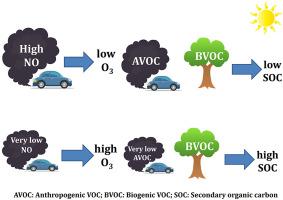当前位置:
X-MOL 学术
›
Atmos. Environ.
›
论文详情
Our official English website, www.x-mol.net, welcomes your
feedback! (Note: you will need to create a separate account there.)
High rise in carbonaceous aerosols under very low anthropogenic emissions over eastern Himalaya, India: Impact of lockdown for COVID-19 outbreak
Atmospheric Environment ( IF 4.2 ) Pub Date : 2021-01-01 , DOI: 10.1016/j.atmosenv.2020.117947 Abhijit Chatterjee , Sauryadeep Mukherjee , Monami Dutta , Abhinandan Ghosh , Sanjay K. Ghosh , Arindam Roy
Atmospheric Environment ( IF 4.2 ) Pub Date : 2021-01-01 , DOI: 10.1016/j.atmosenv.2020.117947 Abhijit Chatterjee , Sauryadeep Mukherjee , Monami Dutta , Abhinandan Ghosh , Sanjay K. Ghosh , Arindam Roy

|
The present study has been conducted to investigate the relative changes of carbonaceous aerosols (CA) over a high altitude Himalayan atmosphere with and without (very low) anthropogenic emissions. Measurements of atmospheric organic (OC) and elemental carbon (EC) were conducted during the lockdown period (April 2020) due to global COVID 19 outbreak and compared with the normal period (April 2019). The interesting, unexpected and surprising observation is that OC, EC and the total CA (TCA) during the lockdown (OC: 12.1 ± 5.5 μg m−3; EC: 2.2 ± 1.1 μg m−3; TCA: 21.5 ± 10 μg m−3) were higher than the normal period (OC: 7.04 ± 2.2 μg m−3; EC: 1.9 ± 0.7 μg m−3; TCA: 13.2 ± 4.1 μg m−3). The higher values for OC/EC ratio too was observed during the lockdown (5.7 ± 0.9) compared to the normal period (4.2 ± 1.1). Much higher surface O3 during the lockdown (due to very low NO) could better promote the formation of secondary OC (SOC) through the photochemical oxidation of biogenic volatile organic compounds (BVOCs) emitted from Himalayan coniferous forest cover. SOC during the lockdown (7.6 ± 3.5 μg m−3) was double of that in normal period (3.8 ± 1.4 μg m−3). Regression analysis between SOC and O3 showed that with the same amount of increase in O3, the SOC formation increased to a larger extent when anthropogenic emissions were very low and biogenic emissions dominate (lockdown) compared to when anthropogenic emissions were high (normal). Concentration weighted trajectory (CWT) analysis showed that the anthropogenic activities over Nepal and forest fire over north-east India were the major long-distant sources of the CA over Darjeeling during the normal period. On the other hand, during lockdown, the major source regions of CA over Darjeeling were regional/local. The findings of the study indicate the immense importance of Himalayan biosphere as a major source of organic carbon.
中文翻译:

印度喜马拉雅东部极低的人为排放量下碳质气溶胶的大量增加:封锁对 COVID-19 爆发的影响
本研究旨在调查高海拔喜马拉雅大气中碳质气溶胶 (CA) 的相对变化,有和没有(非常低的)人为排放。由于全球 COVID 19 爆发,在封锁期间(2020 年 4 月)对大气有机物 (OC) 和元素碳 (EC) 进行了测量,并与正常时期(2019 年 4 月)进行了比较。有趣的、意外的和令人惊讶的观察是锁定期间的 OC、EC 和总 CA (TCA)(OC:12.1 ± 5.5 μg m-3;EC:2.2 ± 1.1 μg m-3;TCA:21.5 ± 10 μg m -3) 高于正常时期(OC:7.04 ± 2.2 μg m-3;EC:1.9 ± 0.7 μg m-3;TCA:13.2 ± 4.1 μg m-3)。与正常时期 (4.2 ± 1.1) 相比,在锁定期间 (5.7 ± 0.9) 也观察到了更高的 OC/EC 比率值。锁定期间更高的表面 O3(由于非常低的 NO)可以通过喜马拉雅针叶林覆盖物排放的生物挥发性有机化合物 (BVOC) 的光化学氧化更好地促进二次 OC (SOC) 的形成。锁定期间的 SOC (7.6 ± 3.5 μg m-3) 是正常时期 (3.8 ± 1.4 μg m-3) 的两倍。SOC 与 O3 的回归分析表明,在 O3 增加量相同的情况下,与人为排放高(正常)相比,人为排放极低且生物排放占主导地位(锁定)时,SOC 形成的增加幅度更大。浓度加权轨迹(CWT)分析表明,尼泊尔上空的人为活动和印度东北部的森林火灾是正常时期大吉岭上空CA的主要远距离来源。另一方面,在封锁期间,大吉岭上空 CA 的主要来源地区是区域性/地方性的。研究结果表明喜马拉雅生物圈作为有机碳的主要来源具有巨大的重要性。
更新日期:2021-01-01
中文翻译:

印度喜马拉雅东部极低的人为排放量下碳质气溶胶的大量增加:封锁对 COVID-19 爆发的影响
本研究旨在调查高海拔喜马拉雅大气中碳质气溶胶 (CA) 的相对变化,有和没有(非常低的)人为排放。由于全球 COVID 19 爆发,在封锁期间(2020 年 4 月)对大气有机物 (OC) 和元素碳 (EC) 进行了测量,并与正常时期(2019 年 4 月)进行了比较。有趣的、意外的和令人惊讶的观察是锁定期间的 OC、EC 和总 CA (TCA)(OC:12.1 ± 5.5 μg m-3;EC:2.2 ± 1.1 μg m-3;TCA:21.5 ± 10 μg m -3) 高于正常时期(OC:7.04 ± 2.2 μg m-3;EC:1.9 ± 0.7 μg m-3;TCA:13.2 ± 4.1 μg m-3)。与正常时期 (4.2 ± 1.1) 相比,在锁定期间 (5.7 ± 0.9) 也观察到了更高的 OC/EC 比率值。锁定期间更高的表面 O3(由于非常低的 NO)可以通过喜马拉雅针叶林覆盖物排放的生物挥发性有机化合物 (BVOC) 的光化学氧化更好地促进二次 OC (SOC) 的形成。锁定期间的 SOC (7.6 ± 3.5 μg m-3) 是正常时期 (3.8 ± 1.4 μg m-3) 的两倍。SOC 与 O3 的回归分析表明,在 O3 增加量相同的情况下,与人为排放高(正常)相比,人为排放极低且生物排放占主导地位(锁定)时,SOC 形成的增加幅度更大。浓度加权轨迹(CWT)分析表明,尼泊尔上空的人为活动和印度东北部的森林火灾是正常时期大吉岭上空CA的主要远距离来源。另一方面,在封锁期间,大吉岭上空 CA 的主要来源地区是区域性/地方性的。研究结果表明喜马拉雅生物圈作为有机碳的主要来源具有巨大的重要性。











































 京公网安备 11010802027423号
京公网安备 11010802027423号